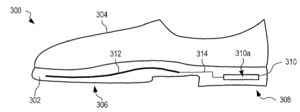As a runner, I know to replace my running shoes every 400 miles or so. Evidently, Apple wants to simplify that process for me. A new Apple patent (number 7911339) at the US Patent & Trademark Office is for a shoe wear-out sensor, body-bar sensing system, unitless activity assessment and associated methods.
Per the patent, a shoe wear out sensor includes at least one detector for sensing a physical metric that changes as a sole of a shoe wears out, a processor configured to process the physical metric over time to determine if the shoe is worn out, and an alarm for informing a user of the shoe when the sole is worn out. A body bar sensing system includes a housing with at least one detector for sensing a physical metric that indicates a repetition movement of the housing when attached to the body bar, a processor for processing the physical metric over time to determine repetitions thereof, and a display for informing a user of the repetitions.
A system assesses activity and displays a unitless activity value. A detector senses activity of a user. A processor reads sensed activity data from the detector. A display displays the unitless activity value. An enclosure houses the detector and the processor. The processor periodically reads the sensed activity data from the detector and processes the data to generate an activity number, the number being used to generate the unitless activity value based upon a maximum number and a display range.
Here’s Apple’s background and summary of the invention: “Shoes (including sneakers or boots, for example) provide comfort and protection for feet. More importantly, shoes provide physical support for feet to reduce risk of foot injuries. A shoe is often necessary to provide support during intense physical activity, such as running, soccer and American football. As a shoe wears, physical support provided by the shoe decreases, thereby reducing associated protection from injury. When a critical wear level is reached, even if the shoe looks like it is not particularly worn, the shoe may not provide adequate support and may, in fact, cause damage to feet.
“In one embodiment, a shoe wear out sensor includes at least one detector for sensing a physical metric that changes as a shoe wears out, a processor configured to process the physical metric, over time, to determine if the shoe is worn out, and an alarm for informing a user of the shoe when the sole is worn out.
“In another embodiment, a system determines the end of a shoe’s life. Use of the shoe is sensed by at least one detector. A processor is configured to measure the use of the shoe and to determine if the shoe is worn out. An alarm informs a user of the shoe when the shoe is worn out.
In another embodiment, a body bar sensing system includes a housing with at least one detector for sensing a physical metric that indicates repeated movement of the housing when attached to the body bar, a processor configured to process the physical metric, over time, to determine repetitions thereof, and a display for informing a user of the repetitions.
“In another embodiment, a system assesses activity and displaying a unitless activity value and includes a detector for sensing activity of a user of the system, a processor for processing sensed activity data from the detector, a display for displaying the unitless activity value, and an enclosure for housing the detector and the processor. The processor periodically reads the sensed activity data from the detector and processes the data to generate an activity number, the number being used to generate the unitless activity value based upon a maximum number and a display range.
“In another embodiment, a method determines a unitless activity value for a desired period of activity. A period accumulator is cleared prior to the start of the activity period A detector is periodically sampled to obtain data that is processed to determine a number representative of the sampling period. The number is added to the period accumulator. The unitless activity value is then determined based upon the period accumulator, a maximum activity number and a display range. The unitless activity value is then displayed. The sampling, processing and adding are repeated until data is sampled for the desired period of activity.
“In another embodiment, a method assesses activity unitlessly by detecting motion of a user, processing the detected motion, over time, to determine an activity value, ratioing the activity value to a maximum activity value, and reporting a scaled unitless activity value to the user based upon the ratio and a scale.
“A software product has instructions, stored on computer-readable media, that, when executed by a computer, perform steps for determining a unitless activity value for a desired period of activity, including instructions for: detecting motion of a user, processing detected motion, over time, to determine an activity value, ratioing the activity value to a maximum activity value, and reporting a scaled unitless activity value to the user based upon the ratio and a scale.”
— Dennis Sellers



